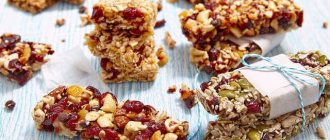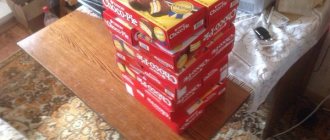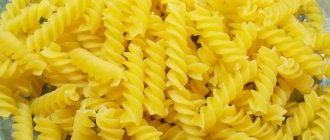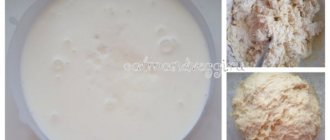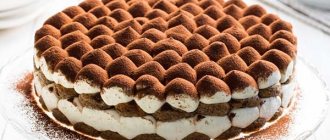Pasta products are semi-finished products made from dough mixed with water. After molding, they are thoroughly dried and subsequently used as food in boiled form. In Rus', every housewife knew how to cook homemade pasta. For Italians, for example, the word “dough” is translated as “pasta”. Therefore, this is what such products are called in this country. Pasta has many varieties: vermicelli, spaghetti, fettuccine, noodles and others. Local housewives also like to cook them with their own hands. Moreover, this can be done in different ways.
Pasta dough
To make homemade pasta tasty and appetizing, you need to know how to properly prepare the dough for it. To prepare it, as a rule, two main components are required: wheat flour and egg yolks. But in this composition it is difficult to mix these products. To obtain a more homogeneous mass, you can add a little water to them. According to the classic Italian recipe for preparing pasta dough, you need to use the following ratio of components:
for 400 grams of flour, the yolks of three eggs, a little salt and 35 grams of water.
You need to prepare the dough gradually:
- First you need to beat the yolks a little. To do this, you can use a whisk or a regular fork.
- Sift the flour through a sieve and pour it onto the table in the form of a slide.
- Make a well in the very center and pour the prepared yolks into it.
- Add salt, add water and mix well. The mass should be smooth and quite elastic.
- Wrap the semi-finished product in cling film and let it sit for at least half an hour.
After this, you can proceed to the next stage - molding:
- The ripened dough must be rolled out into a thin layer, and then sprinkled with flour and rolled into a roll.
- Cut into pieces with a sharp knife. After that, each of them must be expanded. You will get even long strips.
- Dry them overnight, spreading them out on a baking sheet.
This homemade pasta can be stored for a month in an airtight container.
Making homemade noodles using a Kenwood kitchen machine
- Place all the ingredients in the mixing bowl and knead the dough on speed 1-2 for about 2-3 minutes. If it gets too thick, just add a little water.
- Next, take out the dough and knead it by hand until smooth, cover with cling film. Let it sit in the refrigerator for 1 hour.
- Then roll out the dough on a dough sheeter into a layer 1 mm thick. On a Kenwood dough sheeter, the pasta feed regulator must be set to position 7 - the noodles will be thin.
- Now comes the fun part - cutting. I thought for a long time about which noodle cutter to buy. I decided on the Tagliolini nozzle. Nowhere on the Internet, not even on the official website, is there any information that this attachment makes paste 1.5 mm wide. I like skinny homemade noodles. When the tagliolini are boiled, they turn out to be 2 mm thick - just right for soup! It looks very appetizing.
- Dry homemade pasta overnight, either on parchment paper or on special pasta dehydrators.
- After cooking the noodles, simply dry the dough roller and noodle cutter, and then brush off the flour with a special brush. You can wipe it with a damp cloth, but you absolutely cannot wash these attachments.
Secrets of quality
To make the right paste, you need to follow the advice of experienced professionals. Any experienced cook knows that homemade pasta will turn out delicious if the housewife follows the following rules:
- It is better to use durum flour and mix it with water. This dough cooks much faster.
- Eggs should only be taken if you don’t have the necessary flour at home. Stores usually sell soft varieties. In addition, a certain proportion must be observed: one egg is required per 100 grams of flour.
- Particular attention should be paid to the preparation of the starting components. It is advisable to sift the flour before use to further enrich it with oxygen. Then the dough will definitely be elastic and homogeneous.
- The duration of the kneading is usually no more than 20 minutes. Longer processing may lead to the destruction of gluten.
- The finished dough must be ripe. To do this, it must be kept for 30 minutes in a cool place.
- It is better to roll out the dough in small pieces on a table sprinkled with flour. The remains must be covered with a towel to prevent them from airing.
- Slicing can be done with a sharp knife or special equipment can be used for this.
Only by taking into account all the rules listed above can you guarantee that the finished products will actually be of the desired quality.
Homemade spaghetti
In Italy they love to cook spaghetti. This type of pasta is especially popular in this sunny country. They are eaten almost every day, seasoned with various sauces. To prepare such homemade pasta, an unusual recipe is often used. To work, you need to take 400 grams of wheat flour, 10 grams of salt, 4 raw eggs and 17-34 grams of olive oil.
Next you need to do the following:
- Sift the flour and carefully pour it in a heap directly onto the table.
- Beat the eggs well. To make the process more efficient, you can add salt to them.
- Make a small hole in the flour with your hand and pour in the prepared eggs along with the butter.
- Knead the dough thoroughly.
- Place it in a cool place for half an hour for better ripening. The semi-finished product must first be wrapped in film or covered with a towel.
- Divide the dough into pieces, and then roll each of them out thinly.
- Prepare spaghetti using a special cutting machine.
Finished products can be cooked immediately. For long-term storage, they must be well dried. To do this, the workpieces must be hung on special devices. If you don’t have them, you can use regular clothes hangers. The result is simply amazing homemade pasta. The recipe is interesting because oil is used instead of water. This gives the products better plasticity and prevents them from sticking together during cooking.
Practical advice
- Along with salt, add a spoonful of vegetable oil to boiling water, and then pasta.
- After cooking, add a piece of butter and stir.
- Do not rinse items with cold water; a sudden change in temperature will cause sticking.
- If desired, after washing, mix with the sauce, then they will not only not stick together, but will also be imbued with the original taste.
Molding Rules
Residents of many countries love to cook pasta. The recipe is not difficult to repeat at home. As a rule, it is extremely simple and requires only certain knowledge, as well as the availability of the necessary equipment. It is mainly required for molding products. As you know, this process can be carried out in two ways:
- Stamping. Using various molds, shaped products are obtained from a sheet of dough. This also includes the production of noodles, when the dough is cut into individual thin strips.
- By pressing. For this purpose, there are special screw presses, the design of which usually ends in a matrix with holes. The shape of the finished product will ultimately depend on the configuration of their cross-section. If the holes are round and solid, then the product is thread-like, and when they are slit-like, the product is tape-shaped or figured. If there are special inserts in the matrix, tubular pasta can be obtained. The recipe at home will depend on what equipment the housewife chooses.
True, not everyone has cutting machines or special presses in their kitchen. Then, for example, to prepare spaghetti, you can use a regular meat grinder.
Step-by-step instructions for cooking pasta
- Pour half the container with water and bring to a boil.
- Salt
- Place pasta in boiling water
- The cooking time is written on the package and depends on the type of pasta.
- Drain, rinse and add oil as desired.
Cooking is a simple matter, but how do you prevent the pasta from sticking together? Housewives have different opinions on this matter, we have collected the most common ones, your job is to test and choose a method that is convenient for you.
Homemade pasta dish
To prepare an original and tasty dinner, you can use regular homemade pasta. The recipe with photos will clearly demonstrate how to do this best. Here, every housewife can show imagination and use non-standard techniques. Take, for example, pasta in cheese sauce. In this case, you will need the following ingredients:
- For the dough - 300 grams of flour, 2 eggs, salt, 50 grams of milk and the same amount of butter.
- For the sauce - 100 grams of sour cream and cheese, an onion and 30 grams of tomato paste.
The preparation of the dish must be carried out step by step:
- First you need to knead the dough.
- Then it needs to be rolled out into the thinnest possible layer. This is best done on a wooden surface to preserve the unique qualities of the product.
- Cut the layer into strips no more than 10 centimeters wide, and then stack them one on top of the other, sprinkling with flour. The workpieces should not stick together.
- Crumble them into thin noodles and then dredge them well in flour.
- To prepare the sauce, first chop and fry the onion.
- Add sour cream and grated cheese to it. A little later, add tomato paste.
- Boil the noodles separately.
- Combine pasta with sauce and mix everything well.
The result is a fragrant and very tasty dish that will certainly bring great pleasure to everyone.
Pasta with mushrooms and spinach
simplyrecipes.com
Choose any mushrooms to your taste: champignons, porcini or any other.
Ingredients
- 300 g curly paste;
- salt - to taste;
- 2 tablespoons butter;
- 2 tablespoons olive oil;
- 600 g mushrooms;
- ground black pepper - to taste;
- 150 g spinach;
- 1 lemon;
- a little grated parmesan;
- a few sprigs of parsley.
Ingredients
Cook pasta in salted water until al dente according to instructions. Drain, reserving one cup of liquid for later.
Melt butter in a saucepan over medium heat. Cook it, stirring constantly, until it turns slightly brown. Remove from heat. Heat olive oil in a frying pan and add chopped mushrooms. Cook, stirring occasionally, until lightly browned. Season with salt and pepper.
Add the pasta, half the chopped spinach and ¼ cup of the pasta water to the mushrooms. Stir and cook until the spinach is slightly wilted. Add the remaining spinach and cook for a few more minutes. If the paste seems dry, add more water.
Then add butter, 2 tablespoons lemon juice and the zest of a whole lemon. Stir, place on a plate and sprinkle with cheese and chopped parsley.
Pasta casserole
For Italians, pasta is dough products in the form of hollow tubes of different diameters and lengths. You can make them in advance, and then store the finished products for a month in paper bags so that you can use them for their intended purpose at any time. In Italy they love to prepare casseroles, the main component of which is pasta. A homemade recipe with a photo will suggest a simple but quite interesting option. First you need to select the necessary products: 500 grams of ready-made pasta, a glass of sour cream, 20 grams of salt, 3 eggs, 50 grams of vegetable oil, 150 grams of hard cheese, breadcrumbs and a little butter.
Cooking method:
- Cook the pasta in salted water for 5-6 minutes after boiling over low heat. After this, they must be thrown into a colander and allowed to drain completely.
- At this time, grind the yolks separately with salt.
- Add sour cream, stir, and a little later add grated cheese.
- Combine the resulting mixture with boiled pasta.
- Separately, beat the whites into a thick foam.
- Add it to the pasta and mix the ingredients very carefully.
- Grease the mold with butter, sprinkle with breadcrumbs and place the prepared mixture into it.
- Bake for 20 minutes in an oven preheated to 190 degrees.
It is better to serve this casserole hot, greasing its surface with butter.
Pasta primavera with vegetables
simplyrecipes.com
Pasta primavera is good to cook in the summer with fresh seasonal vegetables that you can find in the kitchen.
Ingredients
- 200 g fusilli (paste in the form of spirals);
- salt - to taste;
- 2 tablespoons olive oil;
- 1 carrot;
- ½ red onion;
- 1 zucchini;
- ½ eggplant;
- ½ bell pepper;
- 1 clove of garlic;
- 100 g tomato paste;
- 1 teaspoon Italian herbs seasoning;
- several cherry tomatoes;
- a few basil leaves;
- a little grated parmesan.
Preparation
Boil the pasta in salted water until al dente.
Heat the oil over medium heat and fry the carrots, cut into small strips, and onion half rings for 5 minutes. Add zucchini and eggplant cubes and sliced peppers. Cook for another 3-4 minutes. Add salt, add chopped garlic, mix well and remove from heat.
Add tomato paste, seasoning and some pasta water. Then add the prepared pasta, halved tomatoes and chopped basil.
Place the pasta on a plate and sprinkle with cheese.
Colored pasta
Even children know that brightly colored dishes stimulate appetite more. That is why every housewife should pay attention to the appearance of the finished product. What about dough products? As a rule, they should have a yellowish tint. It is mainly due to the presence of eggs. But this is not the only option. An experienced housewife knows how to make homemade pasta so that just by looking at it you immediately want to eat it. To give dried semi-finished products different shades, you can use natural food colors in the form of vegetable additives (spinach, carrot, beet or tomato juice). They must be added to the dough partially instead of water. In this way you can prepare multi-colored pasta, which will look very impressive in a plate. To work, you will need 50 milliliters of green basil, carrot and fresh tomato juice, 8 eggs, 1.2 kilograms of flour and 50 milliliters of water.
Process technology:
- Divide the flour into 4 parts and pour them into piles on the table.
- Add water to one of them, and juices to the others.
- Add beaten eggs to each portion and knead the dough.
- Cut the noodles in any convenient way. If you have a special machine for this, the process is significantly simplified.
- Roll the finished semi-finished products into rings or nests and leave them to dry in a well-ventilated area.
After this, the finished products will only need to be boiled. They will make an original and very beautiful side dish.
Preparation:
First way
Sift half the rye flour and half the wheat flour. Add 2 pinches of salt and stir.
Why do I use a mixture of two types of flour? Everything is very simple! I found “my” taste of pasta, which my family also likes. This means that it is not necessary to repeat exactly these proportions! But I will say a few words in favor of my choice. The fact is that by mixing different types of flour, I get:
- More interesting taste of products;
- Not the pale appearance of the pasta;
- The pasta is tasty and al dente, and slightly overcooked (this is due to gluten... I’ll talk about this a little later).
Just keep in mind that there is very little gluten in rye flour, which means that a little more water (liquid) is required than for dough made with wheat flour. You need to focus exclusively on the density of the dough, at which it no longer sticks to your hands.
Add the egg yolk. Gently mix with flour layer by layer.
Wow! But this time one yolk was not enough for me! The dough simply refused to become one. Therefore, I introduced another 0.5 part of the protein. But let me draw your attention to the fact that this is only in this particular case! And since the quality of both one and the other flour may be different for us, we focus (as I already said) on the density of the dough.
We continue to knead the dough on the table. But keep in mind that you still won’t be able to get elastic dough. You need a proofing time of 30, or even 50 minutes!
Roll the dough into a ball and place it in a bag. Place the package of dough in the refrigerator to proof.
Second way
In the same way, sift and mix 30-35 grams of rye and corn flour. Mix dry ingredients, adding salt.
Pour water into the well in the middle of the dough. We add water in 2-4 stages to get the consistency we need: we may not need all the water.
Continue kneading the dough on the work surface. Then put the dough in a bag and put it in the refrigerator.

